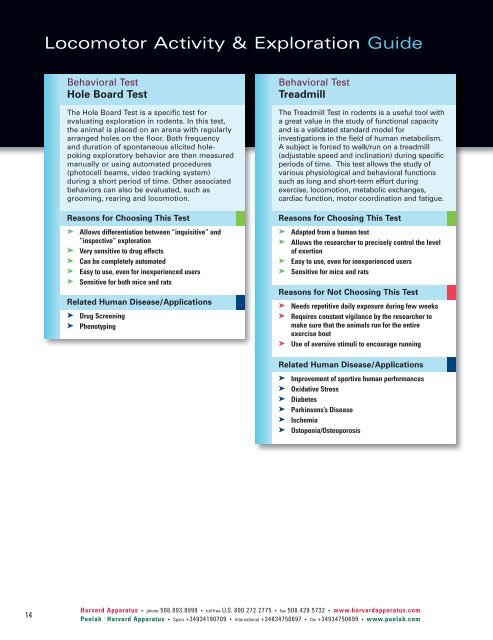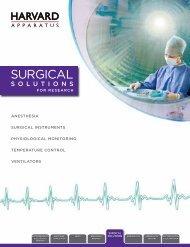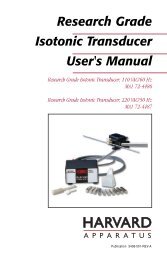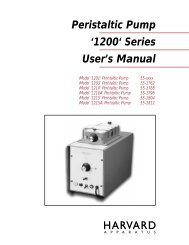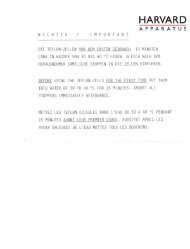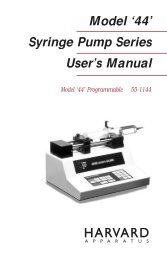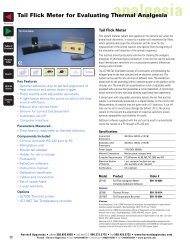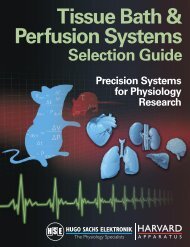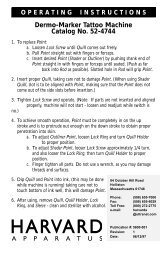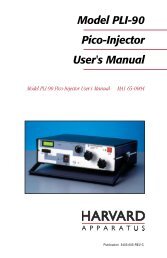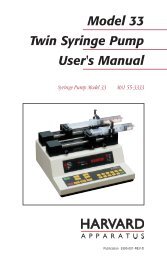View Catalog PDF - Harvard Apparatus
View Catalog PDF - Harvard Apparatus
View Catalog PDF - Harvard Apparatus
Create successful ePaper yourself
Turn your PDF publications into a flip-book with our unique Google optimized e-Paper software.
Locomotor Activity & Exploration Guide<br />
Behavioral Test<br />
Hole Board Test<br />
The Hole Board Test is a specific test for<br />
evaluating exploration in rodents. In this test,<br />
the animal is placed on an arena with regularly<br />
arranged holes on the floor. Both frequency<br />
and duration of spontaneous elicited holepoking<br />
exploratory behavior are then measured<br />
manually or using automated procedures<br />
(photocell beams, video tracking system)<br />
during a short period of time. Other associated<br />
behaviors can also be evaluated, such as<br />
grooming, rearing and locomotion.<br />
Reasons for Choosing This Test<br />
➤<br />
➤<br />
➤<br />
➤<br />
➤<br />
Allows differentiation between “inquisitive” and<br />
“inspective” exploration<br />
Very sensitive to drug effects<br />
Can be completely automated<br />
Easy to use, even for inexperienced users<br />
Sensitive for both mice and rats<br />
Related Human Disease/Applications<br />
➤<br />
➤<br />
Drug Screening<br />
Phenotyping<br />
Behavioral Test<br />
Treadmill<br />
The Treadmill Test in rodents is a useful tool with<br />
a great value in the study of functional capacity<br />
and is a validated standard model for<br />
investigations in the field of human metabolism.<br />
A subject is forced to walk/run on a treadmill<br />
(adjustable speed and inclination) during specific<br />
periods of time. This test allows the study of<br />
various physiological and behavioral functions<br />
such as long and short-term effort during<br />
exercise, locomotion, metabolic exchanges,<br />
cardiac function, motor coordination and fatigue.<br />
Reasons for Choosing This Test<br />
➤ Adapted from a human test<br />
➤ Allows the researcher to precisely control the level<br />
of exertion<br />
➤ Easy to use, even for inexperienced users<br />
➤ Sensitive for mice and rats<br />
Reasons for Not Choosing This Test<br />
➤ Needs repetitive daily exposure during few weeks<br />
➤ Requires constant vigilance by the researcher to<br />
make sure that the animals run for the entire<br />
exercise bout<br />
➤ Use of aversive stimuli to encourage running<br />
Related Human Disease/Applications<br />
➤<br />
➤<br />
➤<br />
➤<br />
➤<br />
➤<br />
Improvement of sportive human performances<br />
Oxidative Stress<br />
Diabetes<br />
Parkinsons’s Disease<br />
Ischemia<br />
Ostopenia/Osteoporosis<br />
14<br />
<strong>Harvard</strong> <strong>Apparatus</strong> • phone 508.893.8999 • toll free U.S. 800.272.2775 • fax 508.429.5732 • www.harvardapparatus.com<br />
Panlab | <strong>Harvard</strong> <strong>Apparatus</strong> • Spain +34934190709 • International +34834750697 • fax +34934750699 • www.panlab.com


